Masterpiece Story: Sky Blue by Wassily Kandinsky
As Europe burned during WWII, Wassily Kandinsky, who had fled Nazi Germany in 1933, lived as a recluse in his Neuilly-sur-Seine apartment. In that...
Javier Abel Miguel 8 January 2026
17 November 2024 min Read
Jean-Antoine Watteau (1684–1721) was the most influential French painter of the 18th century. His painting Pilgrimage to the Isle of Cythera captures the frivolity and sensuousness of Rococo painting, but it also captures the stages and growing nature of love. Let us explore a Watteau masterpiece, let us explore a Rococo romance.
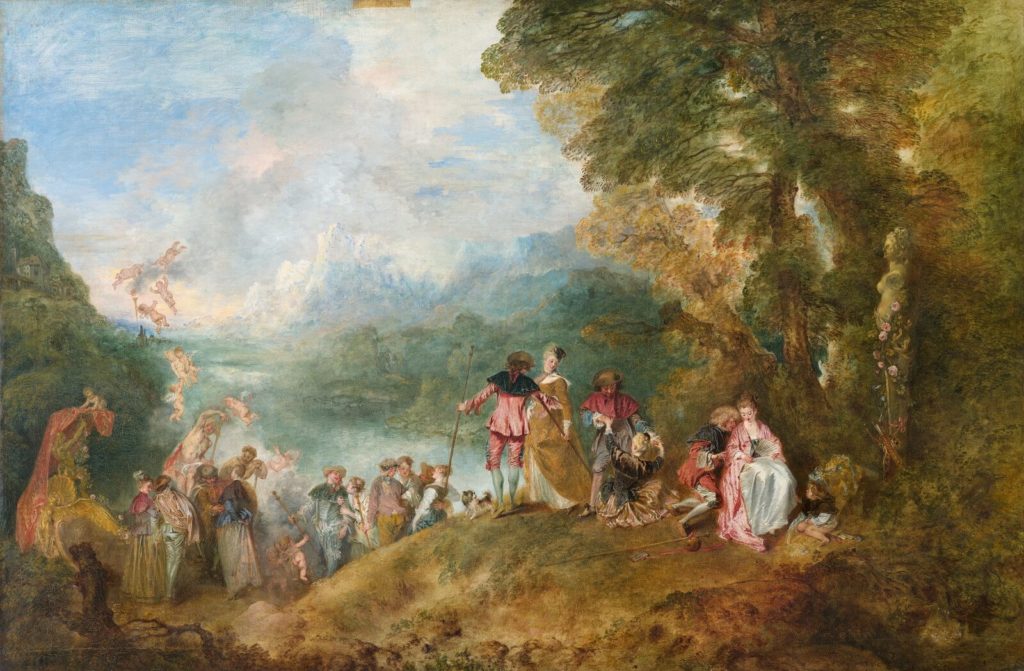
Like anything organic, love has a lifespan. It is born, it grows, it matures, it withers, and it dies. Some love is a slow-burning ember that lasts decades, while some love is a fast-burning flame that lasts days. Whether it lasts days or decades, the beginning always feels the same – exciting, exhilarating, and full of possibility and hope. The question is always asked, “Is this the one?” Jean-Antoine Watteau explores the beginning of love through his masterpiece, Pilgrimage to the Isle of Cythera.
Jean-Antoine Watteau submitted Pilgrimage to the Isle of Cythera in 1717 to the French Royal Academy of Painting and Sculpture. It was his morceau de réception, or entry piece, to gain admission to the prestigious institution. The painting caused quite a stir with its vibrant colors, bold brushstrokes, and hazy atmosphere. The lush landscape is idyllic and infused with bright blue skies, soft green leaves, and warm brown earth. The beautiful people are fashionably dressed in silk and velvet. Hats, fans, and walking canes add to their glamorous appearance.
They are aristocrats having flirtatious conversations in an idyllic country setting. Such courtly scenes in the open air were a new painting style. The French Royal Academy had never seen such a subject. They knew of history paintings, Biblical scenes, and still-lifes, but what is this theme? The academy created a new painting genre just so it could accept Watteau as a new academic member. They called this new genre fête galante, or gallant party.
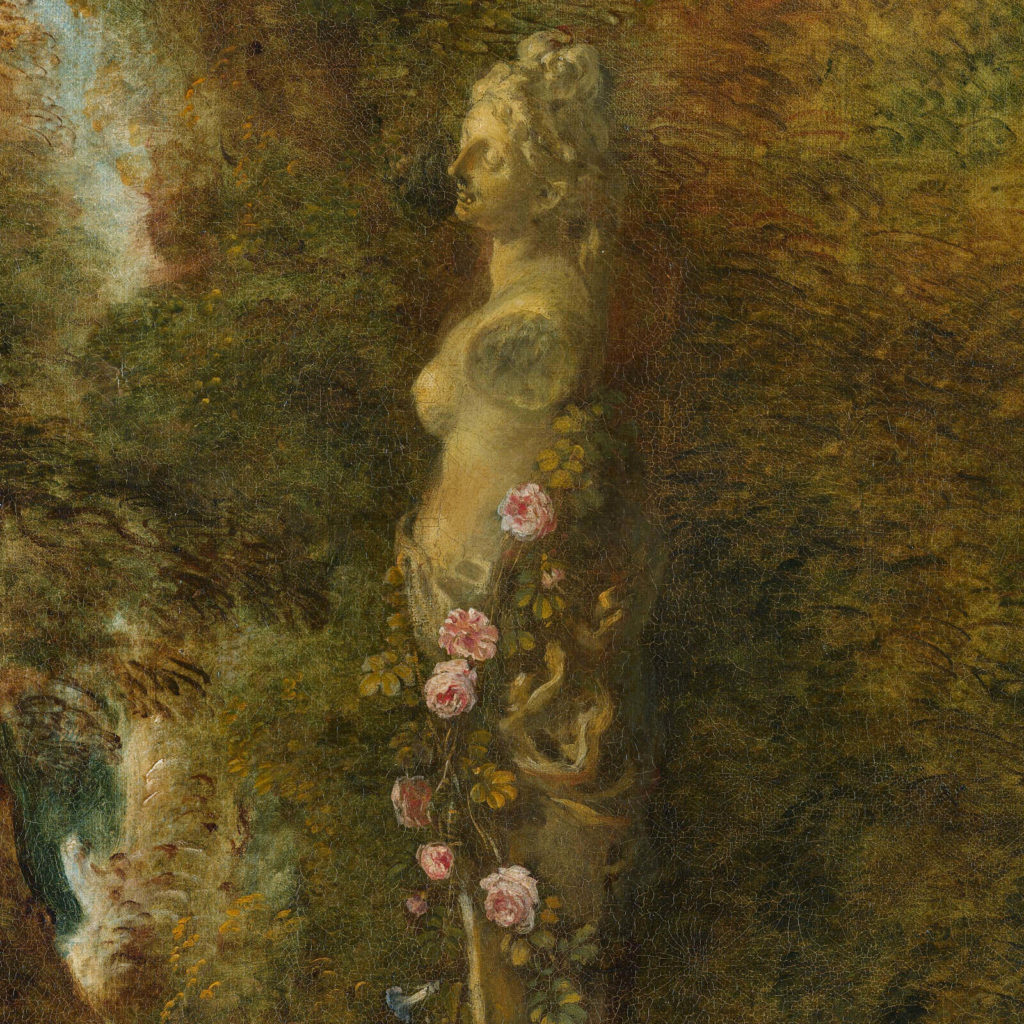
The background to these flirtatious aristocrats is the sacred Greek island of Cythera where Aphrodite, the Goddess of Love, was allegedly born. A statue of the goddess stands on the right side of the painting overlooking all who visit her island. It blesses all visitors with love and affection. Aphrodite’s image is a Neoclassical statue with pink roses growing up its base. The rose blossoms represent love’s beauty, but the rose thorns represent love’s difficulty. The statue looks kindly upon the couples, but she understands that they will soon leave her sacred island forever. She knows they will eventually leave for the profane world with love as their protection.
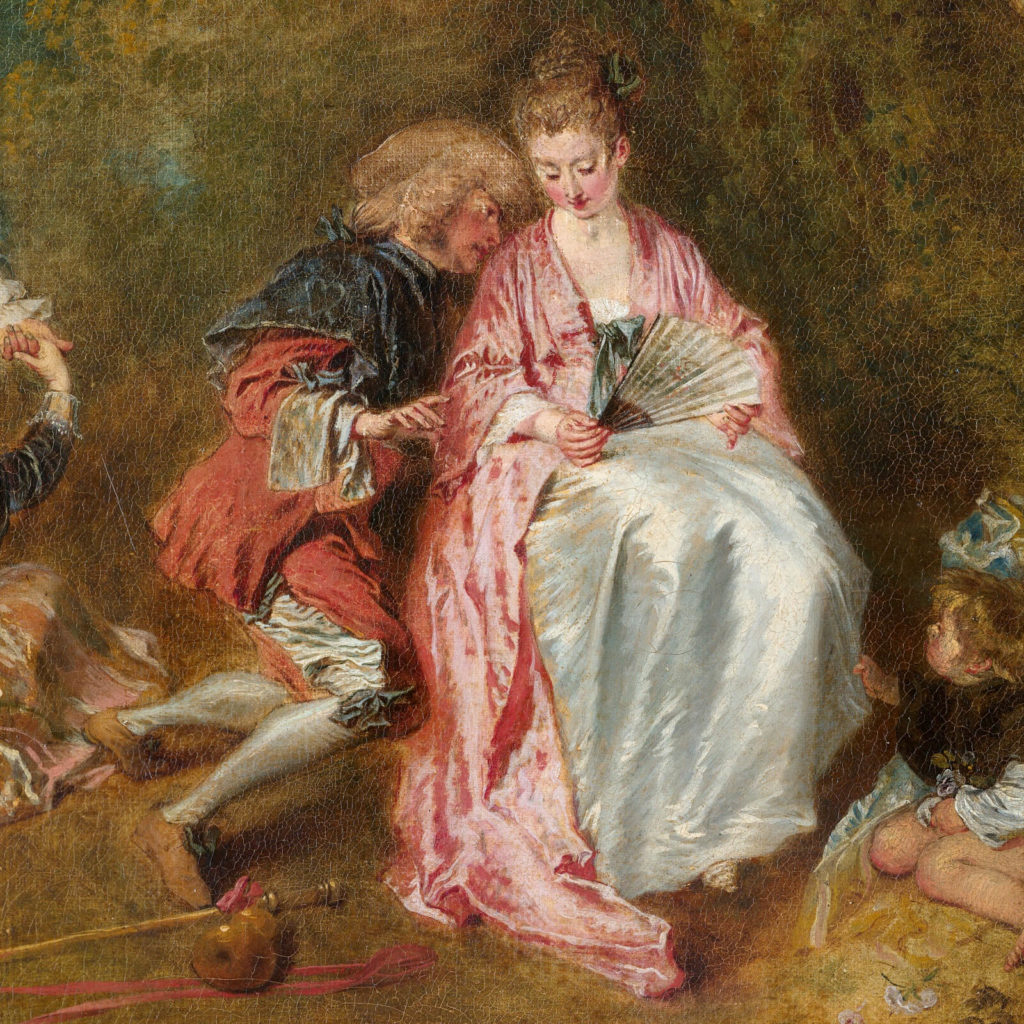
To the left of Aphrodite’s statue is the first couple. The lady and gentleman sit on the grass and are in an intimate conversation. On the man’s shoulder, his blue cape is embroidered with a heart pierced by an arrow. It symbolizes his love-struck intentions with this young lady. Judging by how near the man is leaning into the woman, the woman is not rejecting his advances. They are having a flirtatious conversation, and at this particular moment, the man whispers in her ear while she glances down demurely, blushes red, and says nothing. All the while her hands fidget with her fan. Perhaps this is her first flirtation and she fidgets because she does not know how to react. Whatever her reaction, this amorous couple in conversation represents the first stage of courtship – flirtation.
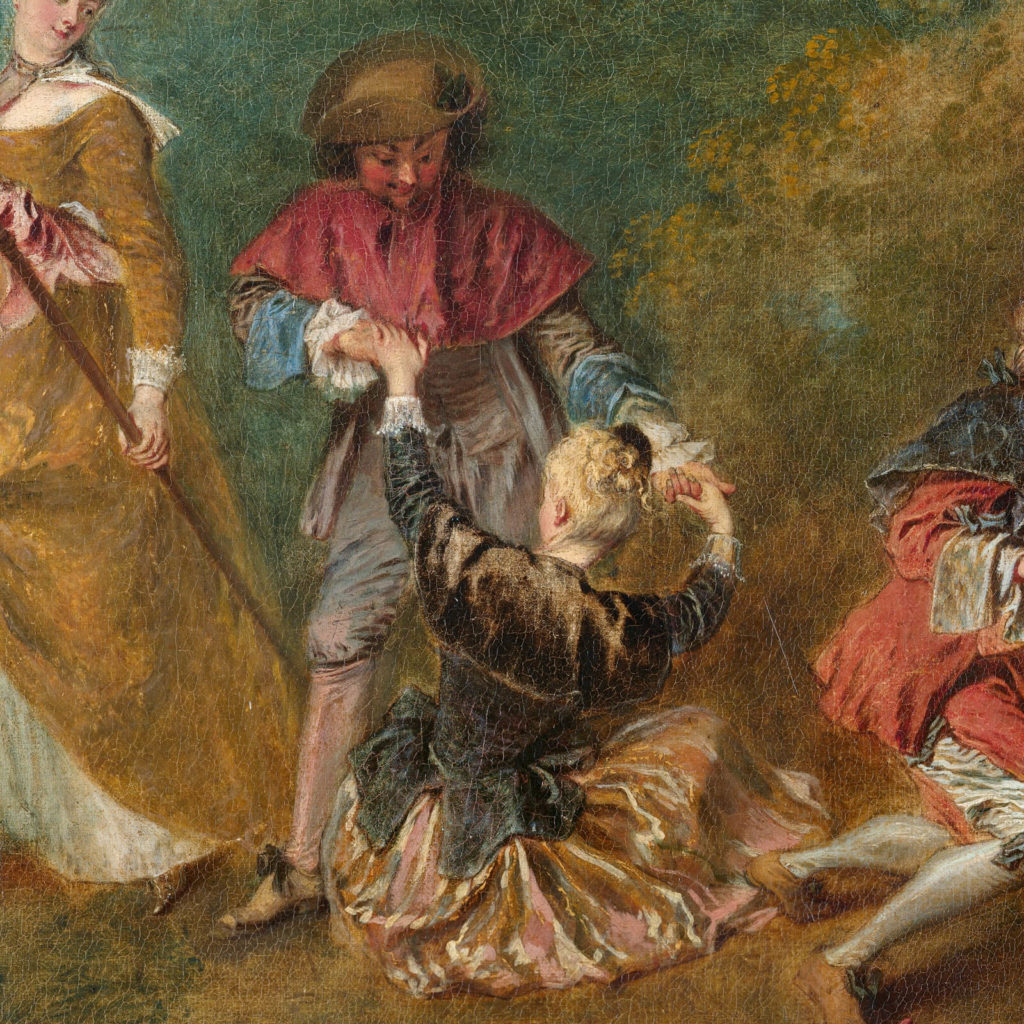
To the left of the first couple is the second couple. The gentleman is holding the lady’s hands and is helping her lift herself from the ground. She wears a gorgeous brown velvet jacket edged in white lace at the cuffs. Her hair is stylishly coiffed. While her admirer holds her hands, he pensively looks deep into her eyes. The implication is strong from the tilt of her head that she is equally looking up into his eyes catching his stare. She gives into his advances. She allows herself to be lifted into his arms. This second couple represents the second stage of courtship – surrender.
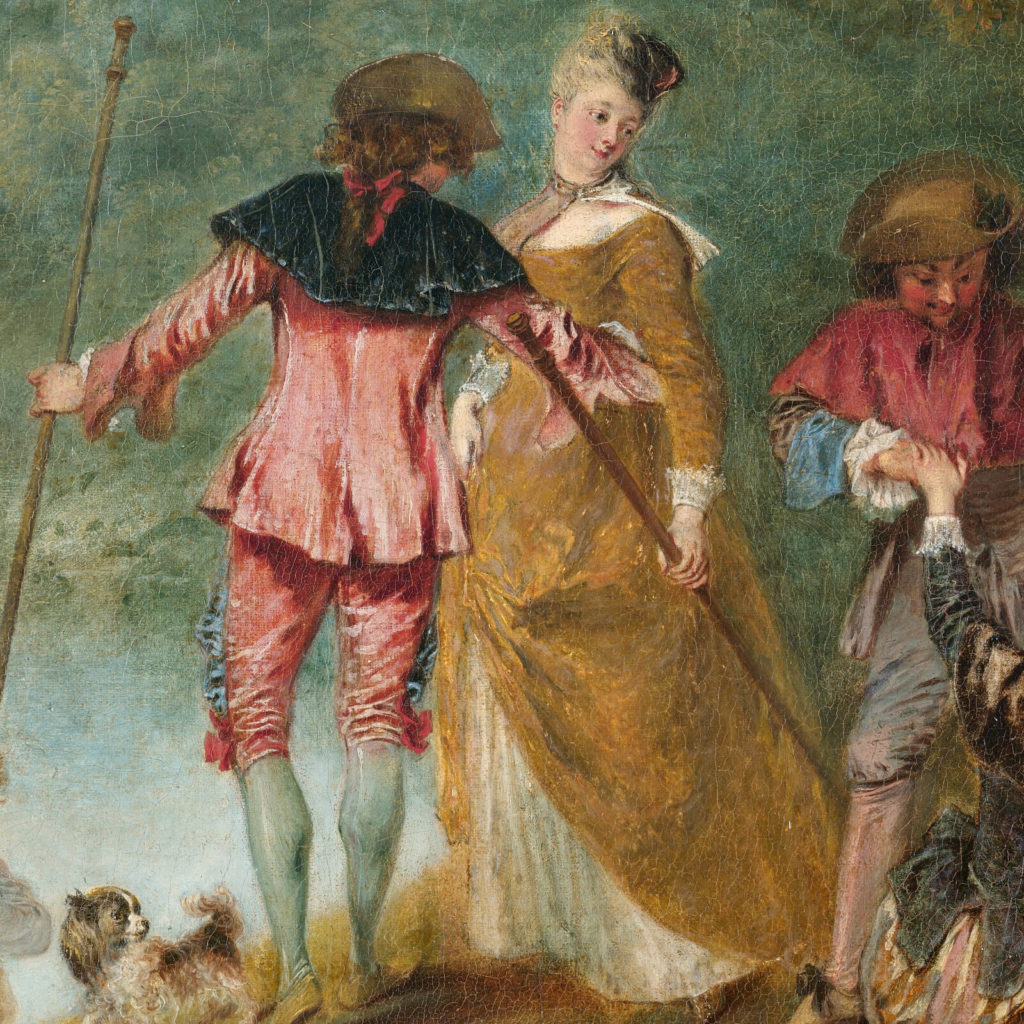
To the further left is the third and final couple of the immediate foreground. In many people’s opinions, they are the most attractive couple of the three. The lady is blonde with rosy cheeks, a full bosom, and an ever-so-chic scarf at her neck. The gentleman has his back to the viewer and wraps his right arm around her waist. He gently tugs her to the left away from the first two couples. He is encouraging her to walk with him, while he holds onto his long walking stick in his left hand. She looks back at the two other couples, and has a look of longing or nostalgia.
Some scholars believe the long walking stick is a phallic symbol and the lady’s unfocused gaze is her reflecting on her surrendered virginity. However, she does not look sad at her loss. Her lips curve into a small but definite smile. The small dog at their feet represents their newfound fidelity. They are now an exclusive couple. Walking together, embraced at the hips, is a symbol of their union. This third couple represents the third stage of courtship – consummation.
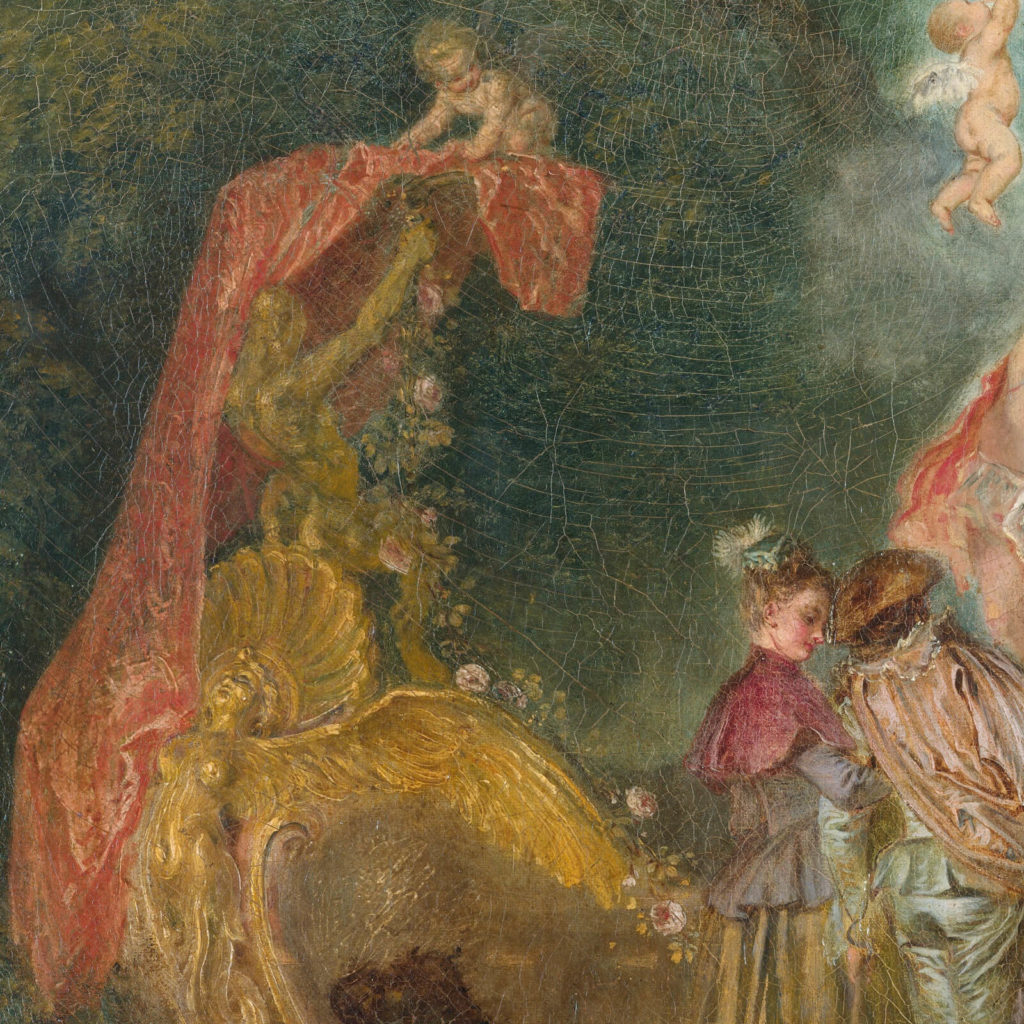
On the far left edge of the painting is a golden barge covered in pink roses, and pink fabric, with ornate sculpted details. A winged angel adorns the prow of the ship. This boat is soon to be filled by the mass of people crowded nearby and the three couples just discussed. The barge will soon take the lovers away from Aphrodite’s island, and return them to the society of the outside world. The voyage may be calm like enduring love or stormy like jealous fury. Such a journey of happy lovers returning together has a historical precedent. The boat may allude to the pleasure barge that the famous Cleopatra sailed on when she met Marc Anthony in 41 BCE. Love, destiny, and glory are all alluded to by this golden boat. Like Cleopatra and Marc Anthony, the couples will face the world together as lovers. Their love gives them the strength to face the world’s problems together. Love has made them invincible. This love boat represents the fourth and final stage of courtship – worldly recognition.
Jean-Antoine Watteau was the most influential French painter of the 18th century. His invention of fête galante was ingenious. His use of vibrant colors was inspirational. His use of bold brushstrokes was daring. Watteau’s style influenced French painters throughout the 18th and 19th centuries. His themes of courtship, falling in love, and love’s triumph are magnificently fused together in Pilgrimage to the Isle of Cythera. This is a Watteau masterpiece, a Rococo romance.
DailyArt Magazine needs your support. Every contribution, however big or small, is very valuable for our future. Thanks to it, we will be able to sustain and grow the Magazine. Thank you for your help!